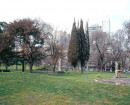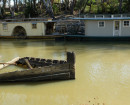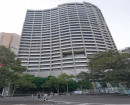DAWSON CACTUS GARDENS
571 NAPIER STREET WHITE HILLS, GREATER BENDIGO CITY
-
Add to tour
You must log in to do that.
-
Share
-
Shortlist place
You must log in to do that.
- Download report


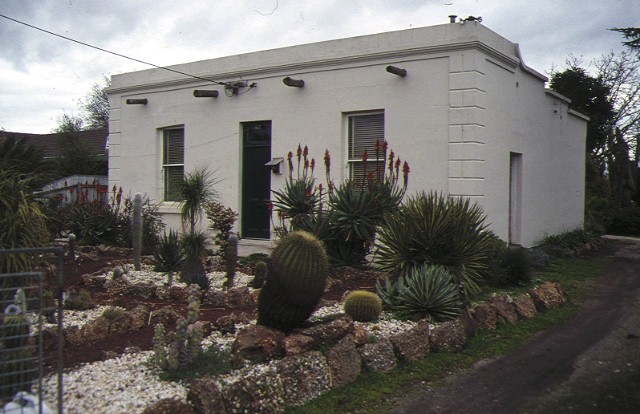
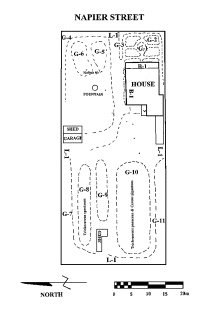
Statement of Significance
What is significant?
Indigenous to the Americas, cacti and succulents were popular in Britain and Europe from the 1830s. In 1880 William Guilfoyle had converted a conservatory at the Melbourne Botanic Gardens into a Succulent House and in 1884 Frederick Sargood had a collection of cacti at Rippon Lea. Extensive use was made of cacti in rockeries created by William Guilfoyle at Melbourne Gardens during 1897-1900. Cacti were popular with amateur gardeners particularly from the 1920s. During the following decades the newly formed Cactus and Succulent Society enthusiastically promoted these plants as did many popular home and gardening journals.
In 1933 Dawson's Cactus Garden was established by Tom H Dawson and Justin Gill on a suburban Bendigo allotment of just over one acre, which still retained its 1867 residence. They planted half a paddock of Pilocereus seeds imported from the United States and within a decade the nursery had become the main supplier of cacti in Victoria and was exporting some of the more exotic species back to their country of origin. An early Dawson & Gill catalogue lists over 2,000 species in their nursery and garden. By 1962 they had maintained the largest cactus nursery in Australia for over 25 years, with a market that covered Australia, New Zealand, Canada, Hong Kong, Malaysia, Great Britain and the United States. The garden remained open until the 1980s when it closed after the death of Tom Dawson. It was sold in 1992 and renamed the 'Bendigo Cactus Garden'. A quarantine shed and propagation house have since been demolished, but the Dawson residence (1867) remains. The former wrought iron front fence and gate is currently held in storage on the property.
How is it significant?
The former Dawson's Cactus Garden is of historic, scientific and aesthetic significance to the State of Victoria.
Why is it significant?
The former Dawson's Cactus Garden has importance for Victoria's garden and horticultural history as the one-time largest and most influential succulent and cacti nursery in the State. The garden and nursery has further cultural importance for its role in shaping the taste of amateur and professional gardeners alike from the 1930s until the closure of the business in the 1980s, as well as for contributing to a wider understanding of horticultural trends in Victoria. The garden is important for its rare role as a former cacti and succulent nursery garden, and today its remaining display plantings continue to be important for their rarity as a diverse collection of specimens. The house, as Dawson's residence, contributes to the historical importance of the garden.
The former Dawson's Cactus Garden is scientifically important for its collection of outstanding individual specimens of cacti and succulents, amongst which are many plants imported in the period prior to restrictive quarantine embargos. Many of these specimens were quarantined at the nursery, and propagated for wider distribution. The collection has further scientific importance for comprising the largest examples of many species now rare in cultivation.
The former Dawson's Cactus Garden is aesthetically important for its concentration of diverse plantings of cacti and succulents which exhibit an assortment of textures and colours, with spectacular shapes and sizes that range from gigantic to dwarf. The dramatic groups of columnar cacti are particularly notable. The garden beds formed by quartz conglomerate edging are notable landscaping features.
-
-
DAWSON CACTUS GARDENS - History
Contextual History:History of Place:
Cacti are indigenous to the Americas and were popular in Britain and Europe from the 1830s. Loudon recommended their cultivation in dry stoves, frames and greenhouses. A cactus craze swept North America in the late nineteenth century and well known Philadelphia nurserymen A. Blanc, in their Hints on Cacti (Philadelphia 1888), recommended cacti for pots, rockery, carpet bedding and even for total garden design.
In 1880 William Guilfoyle had converted a conservatory at the Melbourne Botanic gardens into a Succulent House and in 1884 Frederick Sargood had a collection of cacti at Rippon Lea. Writing in his Handbook of Australian Horticulture (one of the earliest Australian books to recommend cacti) H. A. James commented that they were ‘admirably suited for pot culture, window or outdoor, for rockeries, and for dry sandy locations’. William Elliot, in Cole’s Australasian Gardening (1896) observed that
On account of their succulent nature they [cacti] are able to endure neglect better than any other kind of plants, as some of them will maintain existence for a considerable length of time without any food; a fact which renders them suitable for amateurs who may be away from home for days altogether ...
Cacti and succulents were very suited to the climate of Victoria’s central goldfields and may still be seen in gardens today. Some species were even used as hedging plants. Extensive use was made of cacti in rockeries created by William Guilfoyle at Melbourne Botanic Gardens during 1897-1900 (when the Yarra River was straightened) in beds near the Temple of the Winds.
In the late nineteenth and early twentieth centuries cacti gained a notorious reputation as a noxious weed due to the spread of Prickly Pear (Opuntia stricta). As early as 1886 the New South Wales Parliament passed the Prickly Pear Destruction Act and following the formation of the Commonwealth Prickly Pear Board in 1920 the insect Cactoblastis was introduced to combat the spread of the ‘pear’. By 1932, after only six years the insect had controlled much of the infestation, although pockets of the plant still remain, especially in the hotter climates of New South Wales and Queensland.
Cacti fell out of favour with informed gardeners of Victoria in the 1920s and 1930s due to the introduction of alpine plants in rockeries. For instance at Burnham Beeches in the early 1930s Alfred Nicholas had a massive rockery with choice alpines, and although the climate of the Dandenongs was not conducive to cacti and succulents, the use of alpines by Nicholas was clearly in advance of popular horticultural tastes.
Cacti remained popular amongst amateur gardeners, and this is clearly evident from Pescott’s remarks in c. 1926 in Gardening in Australia:
The ‘Rock’ Garden in Australia is quite a different proposition to the rock garden in the Northern Hemisphere. In the north, rock gardens are usually the home of alpine plants, or plants of a small herbaceous habit. They are usually miniature alpine hill morains ... [Instead] we construct a miniature dry country rock garden ... Our rock gardens or ‘rockeries’ are furnished with Cactus ... and other succulents.
In 1926, the Garden and Home Maker of Australia spoke of ‘The charm of rock gardens: A delight within reach of us all’. By the 1930s, 1940s and 1950s many popular gardening journals had ‘Cactus’ columns and the Cactus and Succulent Society of Australia was formed during this period. Specialist nurseries such as Ralph Field at Tennyson, Dawson and Gill of Bendigo, and Himmerman’s Mexicana Cactus Nursery in North Essendon supplied enthusiasts although their general popularity waned after World War II and it was largely left to devotees to pursue collecting single mindedly.
History of Place:
The land in the Bendigo suburb of White Hills on which this garden stands was sold by the Crown to builders Edward and S. Marks on 25 April 1867. The existing residence dates from 1868 and is distinguished by octagonal pairs of chimneys. In 1933 Dawson’s Cactus Garden was established on the allotment by Tom H. Dawson and Justin Gill, after Tom’s wife Myrtle Dawson had started the enterprise by purchasing two cacti. Before this Tom had been a milkman. One of the first things they did was plant half a paddock of Pilocereus seeds imported from the United States. Within a decade the nursery was exporting some of the more exotic species back to America, and had become the main supplier of cacti to Victoria. Of the site Gill wrote:
In Bendigo, Victoria, shade temperature in summer often goes well above the century, and in winter the soil is often frozen hard, inches down. Rain falls mostly in winter, averaging 22 inches annually. Here cactus growing is an outdoor game. We all try to grow cactus and other succulents to look like and act like what they are.
Dawson & Gill advertised in 1948:
We grow the Rare Ones ... Don’t just read about them, see the big specimens really growing and flowering ... in the largest cactus nursery in Australia. Write, or phone Bendigo 1370 for our lists - or better still ... COME UP AND SEE US SOME TIME.
An early Dawson & Gill catalogue held by the National Herbarium of Victoria lists over 2,000 species in their nursery and garden.
The Cactus and Succulent Society of Australia, established prior to World War II, made an annual ‘pilgrimage’ to Ralph Fields’ cactus collection at Lockington, north of Bendigo. A stop for lunch at Dawson’s was usually mandatory. In 1952 one member commented:
What a sight for cactophiles! ... we were welcomed by Mr & Mrs Dawson and went on a tour of their very large collection of Cacti and Haworthias. I saw many large specimens known to me only by names and I would like to have spent more time going over their plants. Among his fine collection are many Mammillarias, many imported before the embargo was put on oversees plants into this country. These plants are quite good sized specimens now and are things of beauty to look at.
A year later another member described the garden:
I was very impressed by the number of cacti they have. The main collection is housed in 30’ x 12’ glasshouse. When looking around this house you notice how healthy the plants all look, I don’t know if its the Bendigo sun or their method of cultivation ... they had a wonderful show of Adromischus and Haworthias in another, small glasshouse.
T. H. Dawson & Gill still advertised in 1962 as the ‘largest cactus nursery in Australia for over 25 years. Satisfied customers in all states, N.Z., Canada, India, Hong Kong,
COMPARISON:
Apart from Dawson’s cactus nursery, there are two other extant cacti gardens which were developed in Victoria in or by the 1940s. These are ‘Whiora’ at Lockington, and the Royal Botanic Gardens. Whiora was commenced in 1927 by the late Ralph Field and is now owned by his son Robert. The location, north Bendigo, is flat with a hot climate very suited to the cultivation of cacti. The garden is landscaped with cacti interplanted with other plants, and a conscious attempt has been made to feature the special physical characteristics of the cacti.
The Cacti Garden at the Royal Botanic Gardens was commenced in the late 1940s although there had been many cacti species incorporated in rockeries prior to this date. The garden formerly held many prized specimens and in recent years much replanting has been undertaken to arrest a period of decline in the garden.
Dawson’s stands in contrast to these two gardens in the manner in which cacti are used in masses rather than for calculated landscaped effects. The Dawson garden also has many structures, such as shade houses and a quarantine shed which assist in an understanding of the horticultural history of cacti in Victoria.
Fine recent collections are held by Atilla Kapitany at the ‘Paradisia Cactus Nursery’ (Garden World, Keysborough), Robert Field at Lockington and by Jim Hall at Strathmerton.
, Great Britain, U.S.A., etc.’. Dawson’s Cactus Garden remained open to for public inspection until the early 1980s. Selling stopped when Tom went to hospital in 1985. It closed following the death of Tom Dawson. The property was purchased by John and Suzanne Martin in December 1992 and re-named the ‘Bendigo Cactus Garden’.
Associated People: Owner TH DAWSON AND J GILL;DAWSON CACTUS GARDENS - Permit Exemptions
General Exemptions:General exemptions apply to all places and objects included in the Victorian Heritage Register (VHR). General exemptions have been designed to allow everyday activities, maintenance and changes to your property, which don’t harm its cultural heritage significance, to proceed without the need to obtain approvals under the Heritage Act 2017.Places of worship: In some circumstances, you can alter a place of worship to accommodate religious practices without a permit, but you must notify the Executive Director of Heritage Victoria before you start the works or activities at least 20 business days before the works or activities are to commence.Subdivision/consolidation: Permit exemptions exist for some subdivisions and consolidations. If the subdivision or consolidation is in accordance with a planning permit granted under Part 4 of the Planning and Environment Act 1987 and the application for the planning permit was referred to the Executive Director of Heritage Victoria as a determining referral authority, a permit is not required.Specific exemptions may also apply to your registered place or object. If applicable, these are listed below. Specific exemptions are tailored to the conservation and management needs of an individual registered place or object and set out works and activities that are exempt from the requirements of a permit. Specific exemptions prevail if they conflict with general exemptions. Find out more about heritage permit exemptions here.Specific Exemptions:EXEMPTIONS FROM PERMITS:
(Classes of works or activities which may be undertaken without a permit under
Part 4 of the Heritage Act 1995)
General Conditions:
All exempted alterations are to be planned and carried out in a manner which
prevents damage to the fabric of the registered place or object.
Should it become apparent during further inspection or the carrying out of
alterations that original or previously hidden or inaccessible details of the
place or object are revealed which relate to the significance of the place or
object, then the exemption covering such alteration shall cease and the
Executive Director shall be notified as soon as possible.
If there is a conservation policy and plan approved by the Executive Director,
all works shall be in accordance with it.
Nothing in this declaration prevents the Executive Director from amending or
rescinding all or any of the permit exemptions.
Nothing in this declaration exempts owners or their agents from the
responsibility to seek relevant planning or building permits from the
responsible authority where applicable.
Buildings and Structures
All works to the interior of the residence which do not affect the exterior of
the registered building
The alteration or demolition of existing unregistered out buildings.
The construction of temporary garden structures.
The erection of temporary lighting and signage, except on the residence
The reconstruction of the original front fence to its original configuration
(supported by photographic evidence), and currently held in storage on the
property.
Landscape
The process of gardening, removal of trees, emergency and safety works.
The management and development of cactus and succulent plant collections and
associated landscaping in accordance with the original concept.
-
-
-
-
-
WHITE HILLS BOTANIC GARDENS
 Victorian Heritage Register H1915
Victorian Heritage Register H1915 -
HILLSBRO HOUSE
 Greater Bendigo City
Greater Bendigo City -
Dawson Cactus Gardens
 Greater Bendigo City H1406
Greater Bendigo City H1406
-
1) ST. ANDREWS HOTEL AND 2) CANARY ISLAND PALM TREE
 Nillumbik Shire
Nillumbik Shire
-
-






